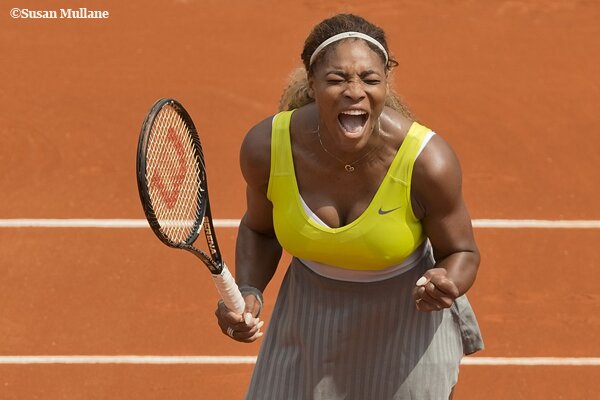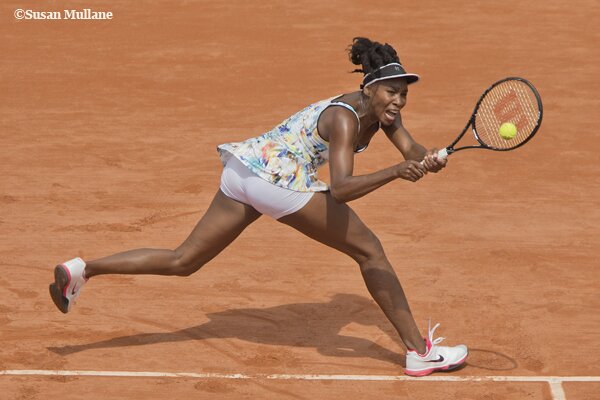By Sandra Harwitt
It’s about that time for Venus Williams to be memorizing a line that becomes many of an advanced age: “Personally, I think age is irrelevant.”
Yes, it’s true that in the greater universe beyond tennis being 33-years-old still qualifies an individual as a young person, someone still with their whole life in front of them. But in the tennis sphere a player of 33 is considered a senior citizen — sad, but true.
The good news for Venus is these days she’s not a lone wolf in the thirty-something sect of the women’s game. In fact, the over-30 group is ever expanding, enough so that the WTA’s media preview notes included the hot new topic: 30 is the new 20.
Among those keeping Venus company in this category is younger sis, Serena, who is now an old-young 32. And even at her advanced age, Serena just so happens to be the No. 1 player in the world and the French Open defending champion.
And there’s even one player who surpasses Venus in age by a whole decade. That’s right, Kimiko Date Krumm of Japan is a grand dame of 43 and still poised to play.
Other women playing at the French Open who are on the list of the tennis medicare eligible are: Francesca Schiavone 33, Lourdes Dominguez Lino 33, Klara Koukalova 32, Flavia Pennetta 32, Li Na 32, Mirjana Lucic-Baroni 32, Iveta (Benesova) Melzer 31, Roberta Vinci 31, Daniela Hantuchova 31, Virginie Razzano 31, Zheng Jie 30, Yvonne Meusburger 30, Chanelle Scheepers 30, and Samantha Stosur 30. If you’re doing the math, that’s a bevy of 17 over-30 world-class athletes.
 Serena is the oldest Roland Garros champion in the Open Era — she was 31 years, 256 days old when she won for the second time here last year. In the past, Zsuza Kormoczy of Hungary was 33 when she conquered the clay here in 1958.
Serena is the oldest Roland Garros champion in the Open Era — she was 31 years, 256 days old when she won for the second time here last year. In the past, Zsuza Kormoczy of Hungary was 33 when she conquered the clay here in 1958.
Nevertheless, no matter how young one might feel and look, and be able to achieve, it’s hard to ignore those players of a certain maturity when it’s all out there to see. And that ’s definitely the case when Venus took to the court on Sunday for her first-round match. Staring across the net from her was the teenaged Belinda Bencic of Switzerland, a young lady who will be crowned the 2013 ITF Junior of the Year at the formal ITF Champions Dinner next Tuesday night.
At 17, Bencic is nearly half Williams’ age and the second youngest player in this year’s women’s competition. If only French wildcard recipient Fiona Ferro wasn’t two days younger than Bencic, the Swiss would’ve earned the distinction of being the youngest in the draw. But two days here and there is pretty negligible, if you know what I mean.
If just pointing out the age difference doesn’t quite set the scene strongly enough then we can also employ another perspective. In the six months following Bencic’s March 10, 1997 birth, Venus Williams played in her first three Grand Slam tournaments, losing in the second round at the French, first round at Wimbledon and miraculously reached the U.S. Open final in her first appearance to Swiss sensation Martina Hingis. (It’s worth noting here that Bencic often trains with Hingis’ mother, Melanie Molitor, when at home in Switzerland).
As it turned out on Sunday, experience prevailed over youth when Williams knocked out Bencic 6-4, 6-1 in the first round.
Venus, wearing a braided swirl of a bun bunched oddly on the side of her head, addressed the issue of the age difference between Bencic and herself with a light and lively touch: “Yeah, young folks today, eh?” she said, chuckling. “I’m just trying to hopefully stay alive myself as an older person. That’s a whole other conversation, I think, about different generations.”
A Lesson Worthy To Learn
If Venus Williams has one message to impart to those coming up behind her — a thought for a player like Bencic — it might be that life doesn’t have to be singularly focused on tennis.
Throughout her years on the tour, Venus has kept to a broad spectrum of interests. At 27, she donned a cap and gown and did the graduation walk to receive her Associates Degree in Fashion Design from The Art Institute of Fort Lauderdale. And she’s well entrenched in the business world: she runs an interior design company – V Starr Interiors — where she spends a lot of time when at home in Florida. The firm has designed hotel rooms to celebrity homes. And she heads EleVen, the casual athletic clothing line that she shows off when on court playing.
And as if that along with her tennis isn’t enough to fill her days completely, she’s gone back to pursuing a bachelor’s degree in business, something she put aside when she was diagnosed a few years ago with the energy zapping auto-immune disease, Sjogren’s Syndrome.
“I’m in business school,” said Williams, as way of an explanation as to why she hasn’t yet read her father Richard’s recently published book. “I have like four classes, so I don’t really do a lot of leisure stuff. I just do a lot of reading and stuff.”
And what’s motivated her to pursue a business degree, which she’s doing online through Indiana University East?
“(I’m) only a few classes off (of my degree),” Williams said. “I wanted to do that because I just thought it would help me out in terms of just being more well-rounded with my design businesses. And I was in school a while, but I had to take some time off because my health went down. I didn’t have the energy to do everything. So, now I’m back and I’m going to close it out, you know, like (when) you’re at 5-1 in the third.”
And in case you’re wondering as to Serena’s assessment of her older, educationally-minded sister, here’s the inside scoop, which was delivered with a smile: “She’s the smarter sister, so that’s why she’s doing so well.”



 25 May 2014
25 May 2014  Posted by Sandy
Posted by Sandy

